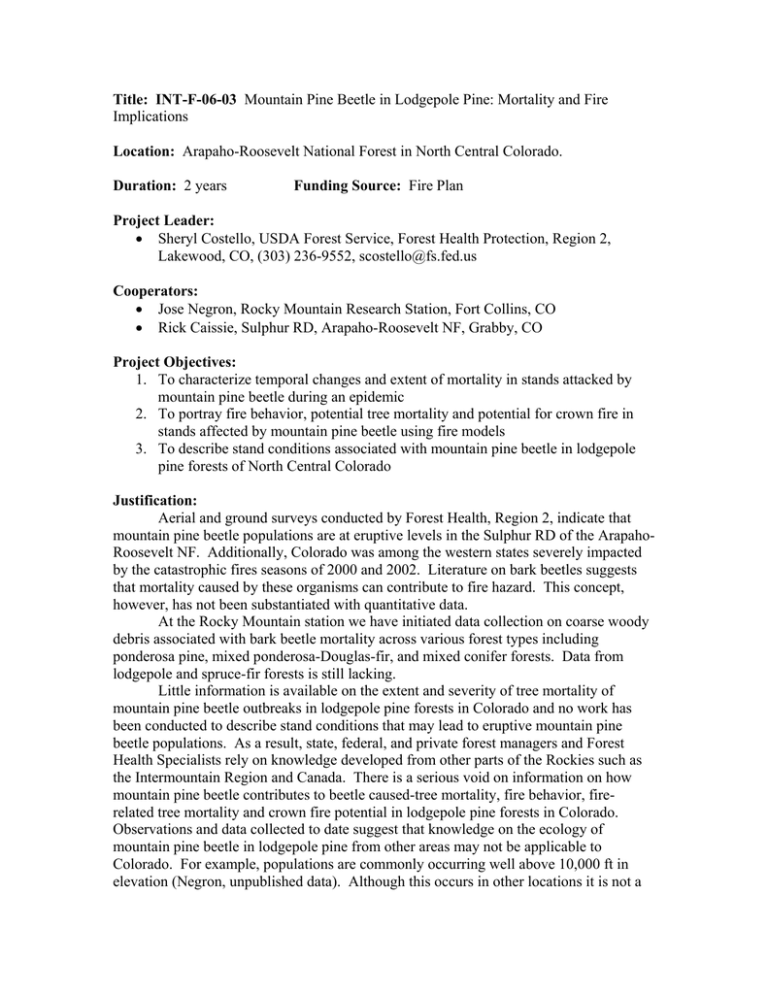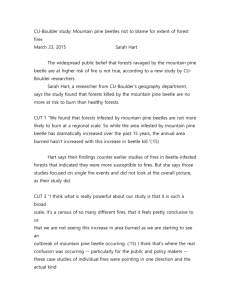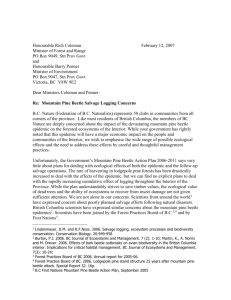Title: INT-F-06-03 Location: Duration: Funding Source:
advertisement

Title: INT-F-06-03 Mountain Pine Beetle in Lodgepole Pine: Mortality and Fire Implications Location: Arapaho-Roosevelt National Forest in North Central Colorado. Duration: 2 years Funding Source: Fire Plan Project Leader: • Sheryl Costello, USDA Forest Service, Forest Health Protection, Region 2, Lakewood, CO, (303) 236-9552, scostello@fs.fed.us Cooperators: • Jose Negron, Rocky Mountain Research Station, Fort Collins, CO • Rick Caissie, Sulphur RD, Arapaho-Roosevelt NF, Grabby, CO Project Objectives: 1. To characterize temporal changes and extent of mortality in stands attacked by mountain pine beetle during an epidemic 2. To portray fire behavior, potential tree mortality and potential for crown fire in stands affected by mountain pine beetle using fire models 3. To describe stand conditions associated with mountain pine beetle in lodgepole pine forests of North Central Colorado Justification: Aerial and ground surveys conducted by Forest Health, Region 2, indicate that mountain pine beetle populations are at eruptive levels in the Sulphur RD of the ArapahoRoosevelt NF. Additionally, Colorado was among the western states severely impacted by the catastrophic fires seasons of 2000 and 2002. Literature on bark beetles suggests that mortality caused by these organisms can contribute to fire hazard. This concept, however, has not been substantiated with quantitative data. At the Rocky Mountain station we have initiated data collection on coarse woody debris associated with bark beetle mortality across various forest types including ponderosa pine, mixed ponderosa-Douglas-fir, and mixed conifer forests. Data from lodgepole and spruce-fir forests is still lacking. Little information is available on the extent and severity of tree mortality of mountain pine beetle outbreaks in lodgepole pine forests in Colorado and no work has been conducted to describe stand conditions that may lead to eruptive mountain pine beetle populations. As a result, state, federal, and private forest managers and Forest Health Specialists rely on knowledge developed from other parts of the Rockies such as the Intermountain Region and Canada. There is a serious void on information on how mountain pine beetle contributes to beetle caused-tree mortality, fire behavior, firerelated tree mortality and crown fire potential in lodgepole pine forests in Colorado. Observations and data collected to date suggest that knowledge on the ecology of mountain pine beetle in lodgepole pine from other areas may not be applicable to Colorado. For example, populations are commonly occurring well above 10,000 ft in elevation (Negron, unpublished data). Although this occurs in other locations it is not a common event. In addition, flight and attack of new trees is taking place well into late September (Negron, unpublished data) also not commonly observed in other locations. The current epidemic is resulting in mortality levels previously undocumented for Colorado. Implications for fire behavior, tree mortality, and crown fire potential at this point are unknown. Moreover, mountain pine beetle populations are problematic for management of high-value recreation areas such as campgrounds and ski areas like Winter Park, Mary Jane, and Solvista resorts and high-value timber production areas within the district. Long-term ecological research studies within the Fraser Experimental Forest and watershed areas for many parts of the Colorado Front Range, including major communities such as Denver, are also being impacted. Description: a. Background Data will be collected in mortality groups from 2000-present to examine forest conditions associated with tree mortality caused by mountain pine beetle, fire behavior, associated fire related tree mortality, and potential for crown fires. Models to be used include Behave Plus for fire behavior, FOFEM for eventual tree mortality, and NEXUS for evaluating potential for crown fires. We have initiated some data collection to address questions posed in this evaluation as resources allowed. Additional support is needed to adequately sample the range of conditions observed in the landscape. b. Methods Aerial survey data and Sulphur Ranger District Risk data will be used to identify areas were populations increased each year from 2000-present. Fixed and variable radius plots will be established to quantify beetle-caused tree mortality over time in relation to diameter classes, stocking (basal area, trees per acre, and stand density index), and growth rates. Brown’s fuel transects, live woody fuel loads, fuel depths, and slope steepness will be used for input to fire models in order to evaluate fire behavior, potential tree mortality, and potential for crown fire. Descriptive statistics will characterize extent of mortality and fire attributes discussed above over time. c. Products The project will document the extent and severity of tree mortality, and provide information on how mountain pine beetle outbreaks in lodgepole pine affect fire behavior, tree mortality, and crown fire potential over time. The data may also be used to calibrate fire models for lodgepole pine forests in Colorado and develop susceptibility models to assist forest manager in identifying susceptible stands for future management. d. Schedule of Activities February – March 2006 Summer 2006 Winter 2006 - 07 Summer 2007 Winter 2007 – Spring 08 Use aerial surveys and forest stand data to identify sampling sites 1st summer field data collection Preliminary data analysis and identification of data gaps or need for adjustments in methods 2nd summer field data collection Final data analysis e. Progress / Accomplishments • Document extent and severity of mortality over time • Quantify coarse woody debris accumulation over time • Use fire models to assess potential fire behavior and subsequent mortality Costs: Item Year 2006 Administration Salary * Overhead (17.8% of admin. and procurements) Travel Procurements Contracting Equipment Supplies Mileage Requested FHM EM Funding OtherSource Funding Source 24,000 4806 1,000 1,000 1,000 31,806 Cost Expenses for 2007 will be similar to those of 2006 *Salaries are for 2 GS-5 technicians for 10 weeks to be stationed at Fraser Experimental Forest.



